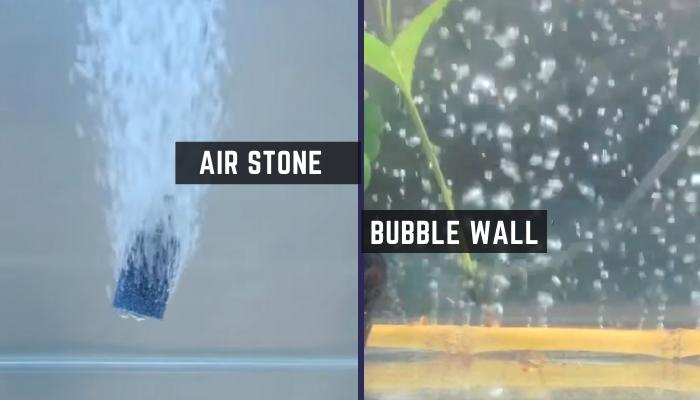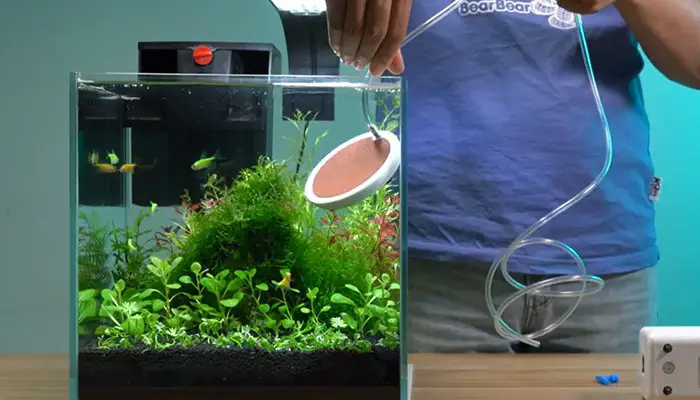
If you keep aquariums often, you should know how important it’s to give the fish dissolved air. However, the average public does not know what air stone or bubble walls are.
What should you choose- air stone vs bubble wall?
Aquatic plants and fish benefit from the addition of air stones. Because they help circulate water. A room’s mood can be set with the help of a bubble wall. Air stones are aquarium accessories that help exchange gas underwater. Whereas bubble wall makes bubbles but doesn’t help much for oxygenation.
You may think which one is appropriate for an aquarium setting. The debate between the air stone and the bubble wall is finally over – thanks to this article!
Air stone vs Bubble Wall: Quick Contrast
As a starting point, you need to know that each device has two distinct functions. It’s absurd to compare the two because one is a functional part of the aquarium. While the other is purely decorative.
Let’s compare the two devices head-to-head before getting into the nitty-gritty. Charts like the one below will assist us in better differentiating between these two devices.
| Features | Air Stone | Bubble Wall |
| Purpose | Creates oxygen bubble and gas exchange | Delivers air and decorative |
| Height | 2” to 4” | 8 feet |
| Length | 4” to 12” | 4 feet |
| Materials | Stone, glasses, ceramics, limewood | Glasses, metal, plastic |
| Price | Affordable | Expensive |
It’s clear from the table that air stone and bubble wall have some significant variances.
Air Stone vs Bubble Wall: In-Depth Review

By now, we should be able to distinguish between Air stone and Bubble Wall. It’s about time we get down to the nitty-gritty of things.
Size
There are numerous different types of airstones, each with a unique shape and size. Limewood, ceramics, glasses, and porous stones can be used to make air stones.
Gray or blue are the most common colors for these gadgets. Round, cylindrical, domed, or rectangular shapes are all possibilities for their shape.
You can find them in a variety of forms and sizes based on your aquarium’s specific requirements. Small (5.5 cm), medium (11 cm), and giant size of air stones are offered (13cm).
The opposite is true for a bubble wall, which is usually a massive decorative element. In the same way, as air stones do, bubble walls are available in a wide variety of forms and dimensions.
A bubble wall can have a maximum height and width of 8 feet and 4 feet, respectively. They’re normally not extremely thick ornaments, with a typical thickness of less than a foot.
Features
The air stone has a tube running through its middle. It attaches to a pump and carries air to porous stone or limewood. The air stone’s pores and holes create thousands of oxygen bubbles.
Whereas in a bubble wall, a pump delivers air through perforations at the bottom of the wall panel. The air rises to the surface of the water, where it condenses as bubbles. With LED lights, the bubble wall can have a different feel or atmosphere.
Exchanging of Gases
The air stone can be used for a variety of things. Take a look at it.
Water circulation in an aquarium is its primary purpose, allowing gases to exchange. Circulating aquarium water facilitates the exchange of dissolved gases like CO2, methane, nitrogen, and oxygen.
A tank’s water and dissolved gases remain in place if no water flows through it. Without proper ventilation, the environment in this space would be much worse.
Tiny oxygen bubbles are carried about the aquarium by the current and undesired gases are released. Micro bubbles air stone moves water and helps to mix the aquarium’s various levels of water.
Most fish live at the aquarium’s bottom, therefore it has less oxygen. Water circulation moves oxygen-rich top layers to the bottom and lower layers to the top.
Filtration
Finally, an air stone can help with aquarium filtration in a little way. Water circulation also prevents organic wastes from settling at the tank’s bottom.
Toxins, mucus, and metabolic waste won’t settle on aquarium corals if the water is flowing. It also works as an aquarium air diffuser.
Now, let’s go into the specifics of how a Bubble Wall works-
Decor
A bubble wall’s principal function is to add visual interest to a room. It has a good aesthetic and adds some artistic flair to any space.
It’s true that a bubble wall’s aesthetic changes over time. But this is not true of other types of art. Anyone in the office or room will enjoy the view.
Distraction
A bubble wall’s unusual look can distract anxious or apprehensive patients in a doctor’s waiting area. As an added bonus, you may design your bubble wall to have an appealingly soothing and therapeutic aspect.
Cost
A bubble wall will be more expensive than an air stone. Bubble walls can be as expensive as $70. Although you can pick up air stones for as cheap as $1.
Ease of Setup

Installing an air stone rather than a bubble wall is much simpler. Connect it to your aquarium’s air pump, and you’re good to go. A bubble wall, on the other hand, necessitates drilling holes in your tank and attaching tubing afterward.
Maintenance
Air stones, as well as bubble walls both, have low upkeep requirements. It is necessary to clean them on a regular basis in order to prevent buildup.
Effectiveness
Using air stones to aerate your aquarium is a great idea. Because they produce so many tiny bubbles, a great deal of oxygen is added to the water.
However, bubble walls produce larger bubbles that dissolve more slowly. You can say they are not equally effective.
Which One is Better?
Either choice will suffice if efficiency is your primary concern. Bubble walls are less effective than air stone at aerating an aquarium.
Moreover, decorative air stones can be used for embellishment. Also, they keep oxygenated water in the tank and prevent deoxygenated water from mixing.
If you have a huge tank with lots of surface area, an air stone may do. However, if you have a small tank or want something more beautiful, consider a bubble wall.
Whatever you decide, be sure it’s a good match for your requirements.
It’s all up to you and what you’re looking for. In the end, both air stones and bubble walls are excellent ways to aerate your aquarium water.
FAQs
Can I Turn Off My Air Stone At Night?
If you have a separate air pump from your aquarium filtration machine, you can turn it off at night.
Is It True That Air Stones Raise The PH Level?
Yes, if your pH is lower than 8.4 or higher than 8.4, an airstone will normally raise your pH.
Do Bettas Enjoy The Bubble Walls?
No, an air bubbler is not required for betta fish. They’ve evolved to thrive in oxygen-depleted, tropical seas with very little dissolved oxygen.
Conclusion
The contrasts between air stones vs. bubble walls were explained in this article. Air stones and bubble walls are two very separate concepts.
There is only one thing they have in common: they both make bubbles. Apart from that, they are distinct in terms of their capabilities, characteristics, and aesthetics.
Hope you find this article helpful. See you in the next article!
- Top 15 Freshwater Aquarium Plant Ideas for a Lush, Green Tank - November 9, 2024
- Top 13 Freshwater Aquarium Layout Ideas for a Beautifully Organized Tank - November 9, 2024
- 14 Stunning Rustic Freshwater Aquarium Ideas for a Tranquil Environment - November 9, 2024
